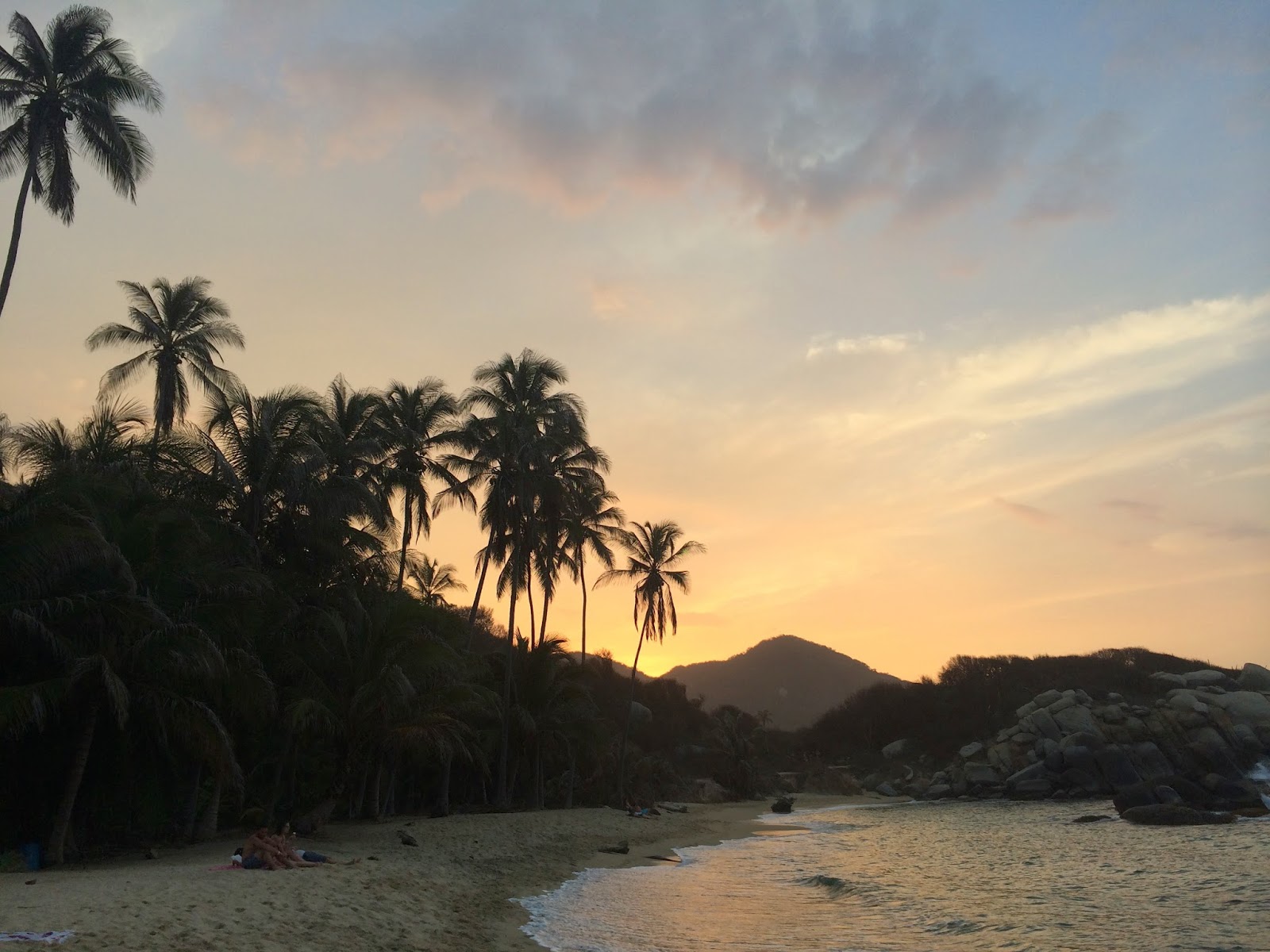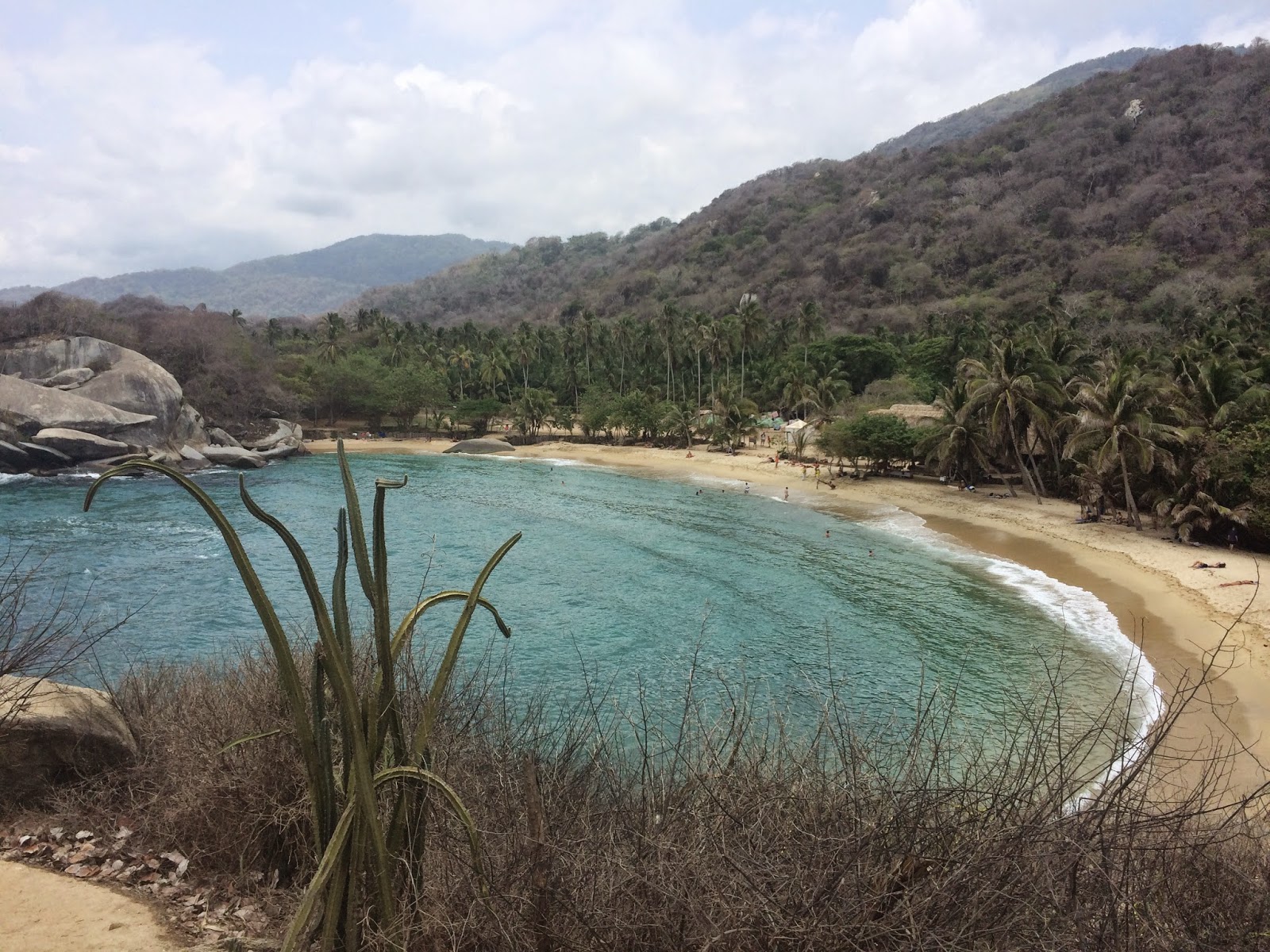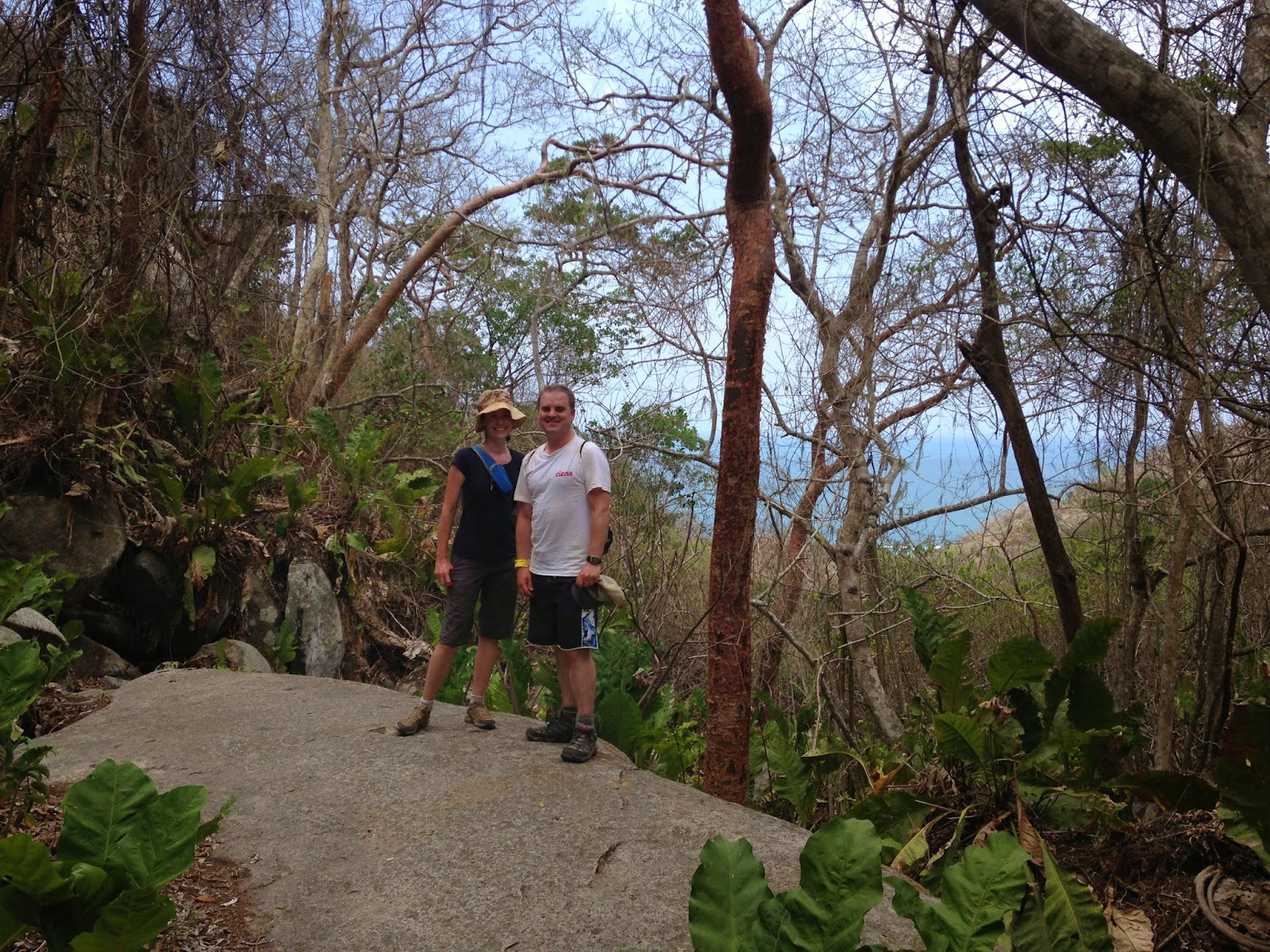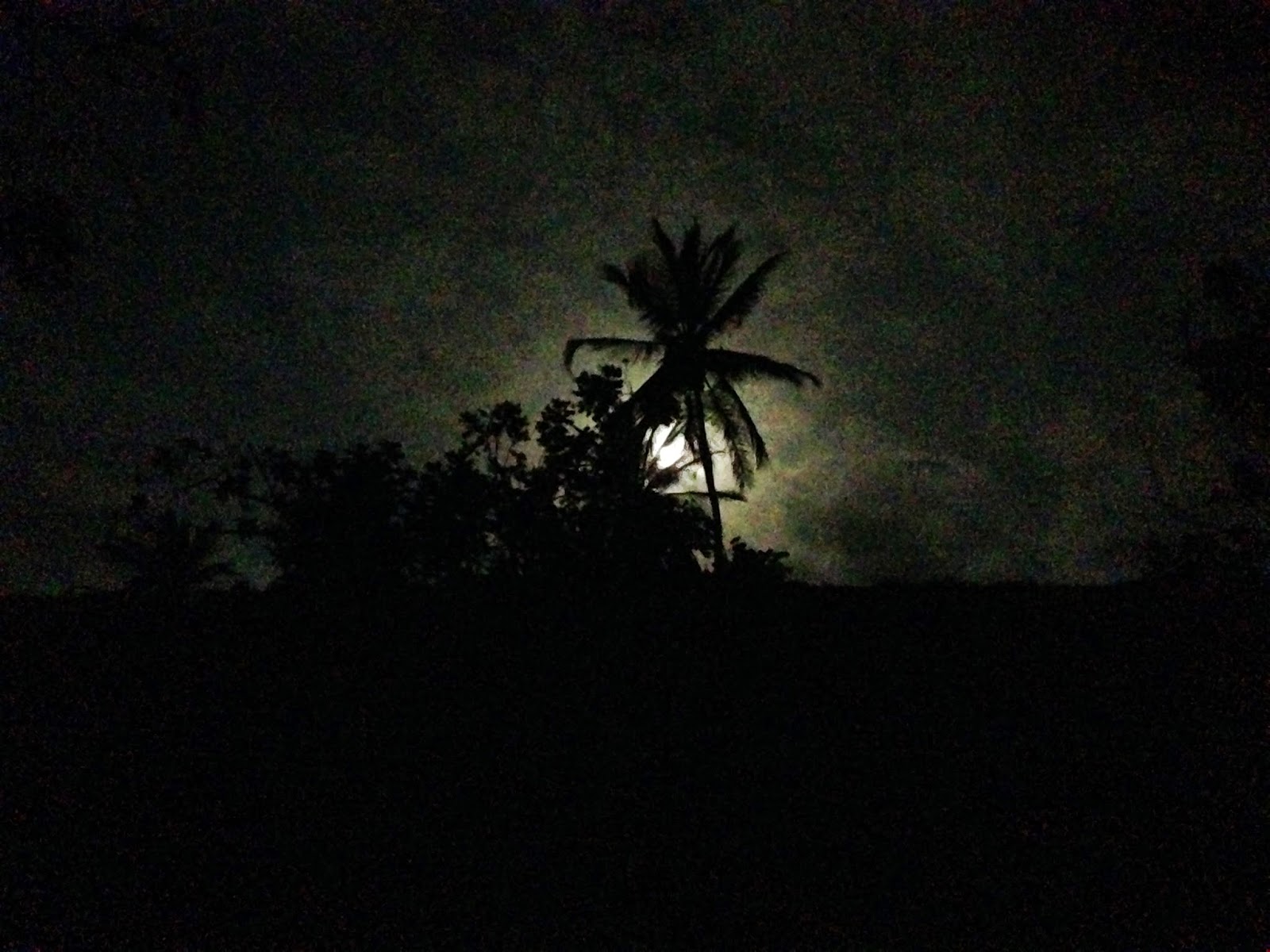Relaxing on the beaches of Tayrona
 |
| Sunset in Tayrona |
The Tayrona National Park is beautiful mix of dense jungle and pristine white beaches, bordering the clear waters of the Caribbean sea in north east Colombia.
Unfortunately for us (and the trees), there had been very little rainfall
in the months leading up to our visit, meaning that the park wasn’t quite as verdant as it usually is.
Yet, it was still more than stunning, and a great place to relax, sunbathe and soak in the sea.
 |
| Blue seas of the Caribbean |
Getting there
From Taganga, where we were staying, it was easy to book ourselves on a tourist bus, which picked us up from our hostel.
It stopped at the checkpoint into the park (where we had to pay an entrance fee) and then took us to the end of the road and to the start of the track into the park.
Its important to make sure your transport is taking you past the checkpoint to the end of the road. Otherwise, its a boring hour walk along the tarmac, before you even start on the path to the beaches and into the park.
At the end of the road, you almost immediately come to the Tayrona Ecohabs at Canaveral beach. This is the most expensive accommodation in the park at around US$300 a night for a cabin sleeping 2-4 people. We walked on past to find the path towards the other beaches and camping grounds.
Past Canaveral, we found the well marked path and walked the 45 minutes up and down the boulder-ey path to arrive at the beach at Arrecifes. It is possible to camp or hire a hammock at the campsite next to the beach.
The campsite looked nice and well set out, with a mouth-watering fresh juice bar. The beach was quite stunning – a long sweeping stretch of sand. However, the signs on the beach made it very clear that it was not safe to swim here. There was also very little shade. We decided to walk on through.
 |
| Treelined walkway |
From Arrecifes, we walked for around 40 more minutes beside the sea to come to a couple of much smaller beaches where we could catch our breath. The beaches here were nice, but quite small and with no campsites. So after a little rest, it was another 20 minutes walk through the trees to Cabo de San Juan.
And it was worth it! There are three beautiful interlinking bays at Cabo de San Juan with trees at the edges offering shade. It is also safe to go in the sea here when you need to cool off – perfect.
 |
| Sweeping bay |
There a few different sleeping options at Cabo de San Juan. There are hammocks to rent both down by the beach and out on a rocky outcrop overlooking the sea.
You can also rent a tent or bring your own hammock or tent. We’d recommend a hammock as it can get very hot in the tents.
 |
| Crashing waves from the rocky outcrop, where you can get a hammock |
 |
| Cabo de San Juan |
The biggest demand is for the hammocks on the rocky outcrop because of the incredible views of the sea and coastline. Apparently, it can also get quite cold up there at night, so make sure you have something to cover your arms and your legs if want to stay there.
On one of our days in the park, we followed the path behind the campsite up to the ruins of El Pueblito.
 |
| El Pueblito |
 |
| Walking back from El Pueblito |
Its around a 2-3 hour hour walk up and a bit less to get back down again. There were people selling overpriced drinks at the top, so don’t worry if you don’t have enough water with you (but make sure you bring cash!).
 |
| Pathway to El Pueblito |
The path starts behind the showers in the Cabo de San Juan campsite and is pretty well marked. There were a few paths at the beginning where we weren’t sure which way to go, but they all seemed to join up with one another, so its quite hard to get lost!
Animal spotting
 |
We spotted a few lizards and frogs on our walk to Cabo de San Juan. However, as quite a lot of people do walk along this path, you do have to be quite quiet and really look out for them, if you want to see them.
Our best animal spotting was on the way up to El Pueblito, as its much quieter. I was particularly pleased to spot a family of monkeys.
But even if you spend your whole time in Tayrona lazing on the beach, you’re sure to see something. This huge iguana was sunbathing with all the tourists the whole time we were there!
 |
| Mmmm Pan Tayrona |
However, when we got to the car park at Canaveral, there were lots of taxi drivers offering similar prices to the minibuses for our group of three (and leaving straightaway). So we hopped in taxi and were back in Taganga in no time at all.
 |
| The pathway is well marked |
The other option is to get a boat from Cabo de San Juan to Taganga, which was a little bit pricier than our taxi. We decided to avoid the boat as we’d talked to people who’d boated in and said they’d got soaking wet, sunburnt and had felt really sick.
In the evenings, it didn’t really get cold. However, bring something that covers your arms and legs for the nighttime, particularly if you are lucky enough to get one of the hammocks out on the rocky outcrop.
You’ll also need toilet paper and a torch!
Other tips and useful things to know
- There is a locker room at the campsite in Cabo de San Juan. The lockers are free to use, as long as you have a small padlock and can find an empty locker.
- Try to leave as much stuff as possible in your hostel at Santa Marta or Taganga. You don’t need much with you in the park and you’ll really notice any unnecessary extra weight on the walk on the way in (and out).
- The showers in Cabo de San Juan are er… interesting. They are mixed gender and although there are cubicles, the walls between the cubicles don’t go right to the ceiling, so you’ll see the head of the person showering next to you. You do have to make an effort if you want to see anything else, but I still felt more comfortable showering in my bikini.
- If you bring lots of stuff with you, you can hire horses to take your belongings (and you) to the campsite of your choice.






